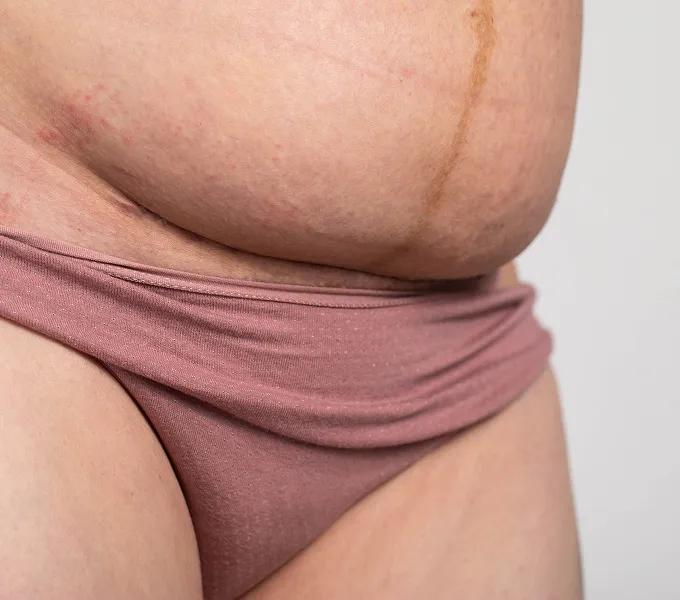
10 Dos & Don'ts for a Safer C-Section Birth Recovery
Whether your cesarean was planned or totally unexpected, recovery is never easy. Too often, healthcare providers dismiss a cesarean as a “basic procedure” that you’ll “bounce back” from in a matter of weeks. They seldom mention what a shock it can be when the pain meds run out and you feel the impact of having had several layers of muscle and tissue cut open to create a safe exit for your baby. Sore doesn’t begin to describe it!
As pelvic floor PTs who specialize in pregnancy and postpartum, we recognize that a cesarean section is a major abdominal surgery, and that recovering while caring for a newborn — and managing all the other changes that your body is going through — is incredibly challenging. We also know that having the right information and support during your recovery can change everything for the better.
Below are some practical tips from the Origin team that will help you recover as safely as possible and get you back to feeling like yourself. Every surgery is different, so be sure to follow your surgeon’s post-op instructions. For more info about how to recognize signs of infection and general recommendations about staying mentally and physically healthy in the weeks after your delivery, check out the American Pregnancy Association.
Do try using silicone gel instead of silicone sheets on your scar.
"Silicone gel sheets have long been recommended as a component of scar care to improve the healing and appearance of your scar. But not using them properly may create an environment for infections to occur, which can complicate healing. Try gently applying a silicone gel instead!" - Liz Miracle PT, MSPT, WCS, Origin Head of Clinical Quality and Talent
Don’t put a heat pack directly on your skin.
"After the first few days of healing, heat may improve discomfort by relieving muscle tension and improving blood flow to your abdominals. But take care to put a few layers of clothing or towels between your incision and the heat pack to prevent burns. Swelling and injury to the nerves in the area may prevent you from being able to feel if the heat is too much, and limit the time you use heat to around 10 minutes at a time. Also, intermittently peek on your skin — it may turn a bit pink as you heat the area and warm to the touch, but should not be bright red, or hot when you feel it with your hand." - Jenna Boyce, PT, DPT, Origin Education Lead
Do start focusing on breathing into your belly.
With the stress of a new baby and pain from the surgery, it can feel difficult to catch your breath sometimes. Spend some time each day gently breathing into your belly (let your belly expand like a balloon while you inhale). This is a safe and gentle way to mobilize the scar tissue that develops in the earlier stages of healing. As a bonus, focus on diaphragmatic breathing exercises will help you to better tolerate any discomfort you may have after surgery, and gently ease you back into using your abdominals and pelvic floor muscles in an easy and pain-free way.
Don’t strain when you poop.
"Poor pushing technique when you have a bowel movement puts a lot of stress on your tummy, and even increases your pain. Good pushing technique is important and involves relaxing your pelvic floor muscles while gently pushing with your abdominals. Try not to hold your breath while you're pushing, instead exhale like you are blowing out a birthday candle. Bonus tip: take a small pillow into the bathroom with you, place it on your lower abdominals to cover the incision, and then gently hug the pillow while you are pushing. This may be helpful for sneezing and coughing as well!" - Leigh Welsh, PT, DPT, OCS, Origin Clinical Director
Do start using your abdominals as soon as you are able after surgery.
"As the saying goes, you need to get back on the horse! And by this, we mean that it is really important to start using your abdominals as soon as possible after surgery. It can feel scary and may even feel like a foreign part of your body, but proper use of your stomach muscles will really help to protect your body and prevent you from straining your incision early on after surgery. Not sure if you’re using them correctly? Check in with your pelvic PT. It is safe to see a pelvic PT within a few days after your delivery, and they can teach you how to safely use your muscles to support your healing, and even recommend ways to slowly start rebuilding the strength in your abdominals with isometric exercises." - Leigh Welsh, PT, DPT, OCS, Origin Clinical Director
Don’t just hop back into your exercise routine where you last left off
Even after your doctor tells you it is safe to return to exercise, your body still needs time to heal and adjust after birth. Common conditions like diastasis rectus abdominis (diastasis recti) or pelvic floor dysfunction need more time to heal. If these conditions are not rehabilitated properly, hopping back into your usual exercise routine may worsen your symptoms. Additionally, research shows that postpartum runners lack the flexibility in their hamstrings and strength in their hips that’s crucial for preventing injury while running.
Instead, consider taking the first few months postpartum to heal and strengthen these areas of your body so that you can build a much stronger and safer foundation before you return to exercise. Here are some key areas to focus on:
- Rehabilitating diastasis recti and pelvic floor dysfunction before resuming high-impact activities
- Increasing flexibility in your hamstrings, which is important for injury prevention
- Building strength in your hip muscles to support safe movement and exercise
Do be aware of your posture.
Think 'tall and open' when sitting or standing. Your body may want to naturally hunch over to guard the front of your body after a cesarean, but in the long run it can lead to increased back and neck pain, and tightness in the scar tissue and muscles of your abdomen. Focus on maintaining a tall posture by keeping a small arch in your low back, and your chest open with your shoulders relaxed down away from your ears and slightly drawn together in your back.
Don’t be afraid to touch your scar.
Touching your scar can sometimes feel hard to do, but it may be the most important step in healing. The scar tissue that your body makes to help close your cesarean incision is critical to healing, but it can also lead to pain, restricted movement, and adhesions. Regularly touching and massaging your scar will help mobilize these tissues, reduce sensitivity, and lower your risks of developing scar-related complications. Hold off on directly massaging your scar until it has fully healed (usually around 6 weeks after birth), but don’t be afraid to touch your scar while you care for it as you heal or gently rest your hand over your scar while you practice those belly breaths.
Do repair your pelvic floor.
You may not have had a vaginal delivery, but these muscles were still in big demand during your pregnancy, leading you to possibly develop or worsen any pre-existing pelvic floor muscle dysfunction. Hormone changes postpartum can also impact your pelvic floor function. These muscles can be easy to neglect with all of the focus on your abdominal healing, but keep your eye out for any symptoms of pelvic floor muscle dysfunction, which can include:
- Leakage (stool or urine)
- Difficulty or pain with bladder emptying
- Constipation/straining to empty bowels
- Pain with vaginal penetration (tampons, sex, pelvic exam)
- Sexual dysfunction
- Pelvic heaviness or a feeling of falling out
- Low back/pelvic pain
- Urinary urgency or frequency
If you are experiencing any of these symptoms, check in with a pelvic physical therapist so that they can help you restore your pelvic floor health as well.
Don’t forget about your emotional health.
"Postpartum depression is common, and research shows that it is possibly even more common 3 months after a cesarean delivery. Your body is no doubt going through a lot during recovery, but don’t forget to check in on your mental health — maybe the circumstances that lead to your cesarean were traumatic, or you’re having more pain and limitations than those after a vaginal delivery — whatever the circumstance, we empower you to take this time to rest, recover, and reach out for help. Let your partner change the baby’s diaper, allow your friends to take care of the laundry, talk to your doctor about how you are feeling emotionally, and consider seeing one of our virtual PTs in the convenience of your own home." - Ashley Rawlins, PT, DPT at Origin



